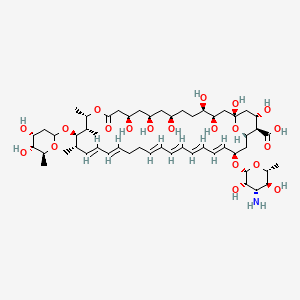| MeSH term | MeSH ID | Detail |
|---|---|---|
| Hemolysis | D006461 | 131 associated lipids |
| Otitis Externa | D010032 | 8 associated lipids |
| Burns | D002056 | 34 associated lipids |
| Body Weight | D001835 | 333 associated lipids |
| Peritonitis | D010538 | 38 associated lipids |
| Anemia, Sickle Cell | D000755 | 34 associated lipids |
| Vaginitis | D014627 | 6 associated lipids |
| Cystic Fibrosis | D003550 | 65 associated lipids |
| Hypertension | D006973 | 115 associated lipids |
| Dermatomycoses | D003881 | 17 associated lipids |
Nystatin A3
Nystatin A3 is a lipid of Polyketides (PK) class. Nystatin a3 is associated with abnormalities such as Mycoses, Candidiasis of the genitals and Gigantism. The involved functions are known as Drug Interactions, Process, Synthesis, Fermentation and Anabolism. Nystatin a3 often locates in Cell membrane, Membrane, Protoplasm, Entire oral cavity and integral to membrane. The associated genes with Nystatin A3 are Gene Clusters. The related lipids are Sterols, 1,2-oleoylphosphatidylcholine, Membrane Lipids, DOPE and N-caproylsphingosine.
Cross Reference
Introduction
To understand associated biological information of Nystatin A3, we collected biological information of abnormalities, associated pathways, cellular/molecular locations, biological functions, related genes/proteins, lipids and common seen animal/experimental models with organized paragraphs from literatures.
What diseases are associated with Nystatin A3?
Nystatin A3 is suspected in Mycoses, Candidiasis of the genitals, Gigantism and other diseases in descending order of the highest number of associated sentences.
Related references are mostly published in these journals:
| Disease | Cross reference | Weighted score | Related literature |
|---|
Possible diseases from mapped MeSH terms on references
We collected disease MeSH terms mapped to the references associated with Nystatin A3
PubChem Associated disorders and diseases
What pathways are associated with Nystatin A3
There are no associated biomedical information in the current reference collection.
PubChem Biomolecular Interactions and Pathways
Link to PubChem Biomolecular Interactions and PathwaysWhat cellular locations are associated with Nystatin A3?
Visualization in cellular structure
Associated locations are in red color. Not associated locations are in black.
Related references are published most in these journals:
| Location | Cross reference | Weighted score | Related literatures |
|---|
What functions are associated with Nystatin A3?
Related references are published most in these journals:
| Function | Cross reference | Weighted score | Related literatures |
|---|
What lipids are associated with Nystatin A3?
Related references are published most in these journals:
| Lipid concept | Cross reference | Weighted score | Related literatures |
|---|
What genes are associated with Nystatin A3?
Related references are published most in these journals:
| Gene | Cross reference | Weighted score | Related literatures |
|---|
What common seen animal models are associated with Nystatin A3?
There are no associated biomedical information in the current reference collection.
NCBI Entrez Crosslinks
All references with Nystatin A3
Download all related citations| Authors | Title | Published | Journal | PubMed Link |
|---|---|---|---|---|
| Sklenár Z et al. | Compounded preparations with nystatin for oral and oromucosal administration. | 2013 Jul-Aug | Acta Pol Pharm | pmid:23923400 |
| Giuliano S et al. | Candidemia in Neurosurgical Intensive Care Unit: preliminary analysis of the effect of topical Nystatin prophylaxis and adequate source control on patients with early tracheostomy intubation. | 2013 Jan-Feb | Ann Ig | pmid:23435780 |
| Pinelli LA et al. | Ricinus communis treatment of denture stomatitis in institutionalised elderly. | 2013 | J Oral Rehabil | pmid:23438045 |
| Shi L et al. | Peptide hormone ghrelin enhances neuronal excitability by inhibition of Kv7/KCNQ channels. | 2013 | Nat Commun | pmid:23385580 |
| Austin N et al. | Prophylactic oral/topical non-absorbed antifungal agents to prevent invasive fungal infection in very low birth weight infants. | 2013 | Cochrane Database Syst Rev | pmid:23543519 |
| Pál S et al. | Technological and biopharmaceutical optimization of nystatin release from a multiparticulate based bioadhesive drug delivery system. | 2013 | Eur J Pharm Sci | pmid:23528741 |
| Wang W et al. | The interaction of polysaccharide from Auricularia polytricha with quantum dots and the protection of plasmid DNA from damage. | 2013 | Appl. Biochem. Biotechnol. | pmid:23440638 |
| Lin TY et al. | Amphotericin B increases influenza A virus infection by preventing IFITM3-mediated restriction. | 2013 | Cell Rep | pmid:24268777 |
| Reis DC et al. | Structural studies and investigation on the activity of imidazole-derived thiosemicarbazones and hydrazones against crop-related fungi. | 2013 | Molecules | pmid:24129274 |
| Maroszyńska M et al. | Antibiotics sensitivity of Candida clinical and food-borne isolates. | 2013 | Acta Biochim. Pol. | pmid:24432323 |
